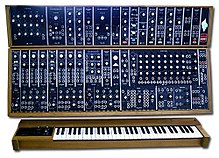| Moog synthesizer | |
|---|---|
 A 1975 Moog Modular 55 system | |
| Manufacturer | R. A. Moog Co. |
| Dates | 1965–1981, 2014–present |
| Technical specifications | |
| Oscillator | VCO |
| Synthesis type | Subtractive |
| Filter | VCF |
| Input/output | |
The Moog synthesizer (/ˈmoʊɡ/ MOHG) is a modular synthesizer invented by the American engineer Robert Moog in 1964. Moog's company, R. A. Moog Co. (later known as Moog Music), produced numerous models from 1965 to 1981, and again from 2014. It was the first commercial synthesizer and established the analog synthesizer concept.
The first Moog synthesizers consisted of separate modules which create and shape sounds, which are connected via patch cords. Modules include voltage-controlled oscillators, amplifiers, filters, envelope generators, noise generators, ring modulators, triggers and mixers. The synthesizer can be played using controllers including keyboards, joysticks, pedals and ribbon controllers, or controlled with sequencers. Its oscillators produce waveforms, which can be modulated and filtered to shape their sounds (subtractive synthesis) or used to control other modules (low-frequency oscillation).
Robert Moog developed the synthesizer in response to demand for more practical and affordable electronic music equipment, guided by suggestions and requests from composers including Herb Deutsch, Richard Teitelbaum, Vladimir Ussachevsky and Wendy Carlos. Moog's principal innovation was voltage-control, which uses voltage to control pitch. He also introduced fundamental synthesizer concepts such as modularity and envelope generators.
The Moog synthesizer was brought to the mainstream by Switched-On Bach (1968), a bestselling album of Bach compositions arranged for Moog synthesizer by Wendy Carlos. Mort Garson used the Moog to soundtrack the televised Apollo 11 moonwalk, associating synthesizers with space in the popular imagination. In the late 1960s, it was adopted by rock and pop acts including the Doors, the Grateful Dead, the Rolling Stones and the Beatles. At its height of popularity, it was a staple of 1970s progressive rock, used by acts including Yes, Tangerine Dream and Emerson, Lake & Palmer. With its ability to imitate instruments such as strings and horns, it threatened the jobs of session musicians and was banned from use in commercial work for a period of time in the United States. In 1970, Moog Music released a portable, self-contained model, the Minimoog.